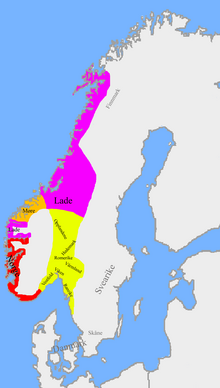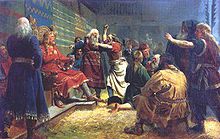Tryggve Olafsson
Tryggve Olafsson († around 968) ( Old Norse : Tryggvi Óláfsson ) was, according to the sagas, the grandson of the Norwegian King Harald Hårfagre . There is no historically reliable information about him. The historical-critical method established by Lauritz Weibull flatly rejects any reliable statements for the history before 1200. The following description is accordingly subject to this reservation.
Tryggve Olafsson is said to have been the grandson of Harald Fairhair and himself (sub) king of Viken on the Oslofjord , as well as of Vingulmark and Rånri. However, this derivation is not supported by contemporary texts, so that one assumes an invention in later times. He was involved in the struggles for the throne after the death of Harald Fairhair (933) and the father of Olav I. Tryggvason , who as King of Norway (995-1000) made a decisive contribution to the Christianization of Norway .
origin
Tryggve was after the " Heimskringla ", the history of the Norwegian kings written down by the Icelandic statesman, historian and poet Snorri Sturluson (* 1179; † 1241) in the 13th century, a son of Olav Haraldsson Geirstadalf († 934), King of Vestfold and Vingulmark, who was probably buried at Gokstaf-Hof in Sandar, Westfold, in the largely preserved Gokstad ship built around 890 , which is now in the Ship Museum on Bygdøy (in Oslo ).
Life
In his youth, Tryggve experienced power struggles between his sons after the death of King Harald I. Fairhair in 931/933. Erik Blutaxt - a younger son appointed by Harald I as his successor - followed as (Upper) King of Norway, but his succession to the throne was disputed by his half-brothers, which led to decades of civil wars. Tryggve was directly affected because his father Olav Geistadalf saw himself as the legitimate successor and therefore had himself proclaimed (counter) king in his sphere of influence - the east of Norway - where he stood in support of his claims and to fight against King Erik I. allied with Sigröd Haraldsson, King of Trondheim .
Finally, at Haugar Manor (near Tønsberg in the province of Vestfold), a decisive battle took place in 934, in which the combined troops were defeated by Tryggve's father and his allies, King Sigröd, and both Tryggve's father and King Sigröd were killed in battle. The place Haugar, where the father Tryggves had fallen, also acquired historical importance for another reason, since the meetings of the Norwegian greats, the Haugarting, were held there for a long time.
A positive turn for Tryggve's life resulted from the fact that the rule of King Erik I was also called into question by another half-brother of Erik, Haakon I Haraldsson, called Athelsteinsfostre. In 934 he lived with his foster father, Aethelstan King of England (924–939). When he found out about the development in Norway, he equipped a fleet with the help of his foster father so that he could intervene in the battle for the Norwegian crown. In Trondheim he was proclaimed king with the help of Jarl Sigurd von Hlader. With his army, King Haakon began to expand his dominion, especially in Vestland , Oppland and Viken , after the saga of King Haakon the Good in 935 Tryggve, he returned the goods of his father confiscated by King Erik I and made him (sub) King of Vigulmark and Rånrike rose. Since Tryggve was still a minor, however, a Regency Council was set up for him.
After the "Heimskringla" Tryggve undertook viking trips to Ireland and Scotland in his younger years . After his return from the Viking voyages, Tryggve was still in the favor of King Haakon I, who, when he went to the north of the country to pacify it in 946, made Tryggve (sub) king of the province of Viken, and charged with defending her against King Erik's sons, who were trying to regain the rule over Norway that their father had lost. Tryggve also received control of the lands still to be conquered, on which King Haakon I had imposed tax payments the previous summer.
King Haakon I. Haraldsson fought in several battles against the sons of Erik Bloodaxe. Although the sagas do not mention this, it can be assumed that Tryggve also took part in these clashes as a nephew and ally. Heavy fighting took place at Avaldsnes in 953 and at Rastarkalv in 955/57 - where the Erik sons were supported by a Danish fleet, in which King Haakon was victorious. Also in the Battle of Fitjar in 961 - where the Danish king Harald Bluetooth to Erik son Harald gray coat supported - remained Haakon victorious, but was hit by an arrow and died of his injuries.
This cleared the way for Harald II. Graufell (Graufell), Erich Blutaxt's third son, to win the Norwegian crown, which he finally wore from 961 to around 970. Together with his brothers, he then set about expanding and stabilizing his rule by eliminating his opponents. This ultimately led to a confrontation with Tryggve, who controlled a substantial part of Norway. Tryggve was lured into a trap and murdered by Gottorm Eriksson, his own half-brother, on behalf of King Harald II. Graufell.
The widow Tryggves, Astrid Eiriksdottir, then fled - accompanied by her foster father Thorolf Lusarskeg - and gave birth to their son Olav Tryggvason on the run. Persecuted by Harald II. Graufell and his people, she had to live in different places of escape for a long time. So also on the estate of her father Erik Bjodaskalle, where in the spring of 964 she barely escaped the attempt to catch her and her son Olav Tryggvason on behalf of King Harald Graufell. She then fled to Hakon Gamle, a friend of her father's.
Marriage and offspring
Tryggve left the following offspring from his marriage to Astrid Eiriksdottir, a daughter of Eirik Bjodaskalle in Oprustader:
- Ingeborg Tryggvadotter, ⚭ around 1000 Ragnvald Ulfsson "the old" (* v. 960; † c. 1030), grandson of the legendary Viking Skoglar Toste , who was Jarl of Västergötland and later Jarl of Staraja Ladoga and Ingrien. (According to the Hervarar saga, Stenkil Ragnvaldsson , King of Sweden (1060-1066), the progenitor of the Stenkil family, comes from his relationship with Astrid Njalsdotter.
- Astrid Tryggvesdatter, ⚭ 996 Erling Skjalgsson , in Sola (near Stavanger ) † December 21, 1028.
- Aslak Erlingsson to Sola; † 1028, ⚭ 1015 Sigrid Svendsdatter; † 1016, daughter of Sven Jarl von Lade
- Skjalg Erlingsson; † August 10, 1062
- Sigurd Erlingsson,
- Lodin Erlingsson; † n. 1098,
- Tore Erlingsson
- Ragnhild Erlingsdatter, ⚭ Thorberg Arnesson (* around 1000, † 1050) to Giske in Møre og Romsdal , from the Giske family )
- Eystein Orre Thorbergsson; † falls at the Battle of Stamford Bridge on September 25, 1066.
- Ogmund Thorbergsson on Giske † in Rome 1103
- Skofte Ogmundsson, the first Norwegian crusader
- Thora Thorbergsdatter (* Giske around 1025; † after 1066), ⚭ 1048 I. Harald III. Hardradi King of Norway, ⚭ 2.) Svend II. Estridssen, King of Denmark (descendants from 1st marriage:
- Magnus II. Haraldsson King of Norway (1066-1069)
- Olav III. Haraldsson , called Olaf Kyrre (the Peaceful), King of Norway (1067-1093)
- Jorunn Thorbergsdatter, ⚭ Ulf Ospaksson “Stallare”; † falls in 1066
-
Olav I. Tryggvason (* 968; † September 9, 1000 in the sea battle at Svolder ), King of Norway (995–1000) ⚭ I. Geira, a Wendish princess, ⚭ II. Gyda, a princess from Ireland, ⚭ III. around 995 Gudrun Skaggesdatter, T. v. Skagge Asbjörnsson, ⚭ IV. Thyra Haraldsdatter, Princess of Denmark; † September 9, 1000, a daughter of King Harald Blauzahn († around 988) and sister of Sven Gabelbart , King of Denmark. From the 2nd and 4th marriage he had one son each, who both died without any chance of rule and without offspring. After King Olav I's death, his brother-in-law, Sven Gabelbart, King of Denmark , also reigned as King of Norway from around 1002. From 1000 to 1015 Jarl Erik Hakonsson, who was married to Gyda Svendsdatter, a daughter of King Sven Gabelbart, was the Imperial Administrator.
- Ulf Ragnvaldsson Jarl in Novgorod
- Eilif Ragnvaldsson Jarl in Novgorod
- Ostrida Ragnvaldsdatter
literature
- Snorri Sturluson: Heimskringla - legends of the Nordic kings. Commented by Hans-Jürgen Hube. Wiesbaden (Marix) 2006; ISBN 978-3-86539-084-4 .
- Claus Krag: Article “Olav 1 Tryggvason” in: Norsk biografisk leksikon
- Winroth, Anders (1995–1997) "Ragnvald Ulfsson", Svenskt Biografiskt Lexikon, Volume 29, Page 616.
- Genealogisk-historiske tabeller over de nordiske rigers kongeslægter (1856), Königsfeldt, JPF, (2nd edition. Kjøbenhavn: Trykt i Bianco Lunos bogtrykkeri, 1856)
- Harald Gustafsson: Nordens historia. In Europeisk Region under 1200 år. Student literature 2007.
Web links
- The saga of Olav Tryggvason (in English translation) [2]
- Heimskringla in engl. Translation: [3]
- Tryggve Olafsson. (2014, November 3). In Norwegian encyclopedia. Retrieved September 5, 2015 [4] .
Individual evidence
- ^ Norsk biografisk leksikon
- ↑ Gustafsson p. 29.
- ↑ C. Krag, Reallexikon der Germanischen Altertumskunde Vol. 22 P. 64.
- ↑ Tryggve Olavsson (Store norske leksikon)
- ↑ The story of King Hakon the Good Cape. 2 in: Snorris King's Book, first volume. Darmstadt. P. 138.
- ↑ King Olaf Trygvason's Saga Part I Chapter 1 [1]
- ↑ European Family Tables NF Vol. II, Plate 107
- ↑ Genealogisk-historiske tabeller over de nordiske rigers kongeslægter (1856), Königsfeldt, JPF, (2nd edition. Kjøbenhavn: Trykt i Bianco Lunos bogtrykkeri, 1856), FHL microfilm 1,124,504, item 3., table 12 p. 150.
- ↑ See wiki article Giske (noble family)
| personal data | |
|---|---|
| SURNAME | Tryggve Olafsson |
| BRIEF DESCRIPTION | norwegian king |
| DATE OF BIRTH | 9th century or 10th century |
| DATE OF DEATH | around 968 |



